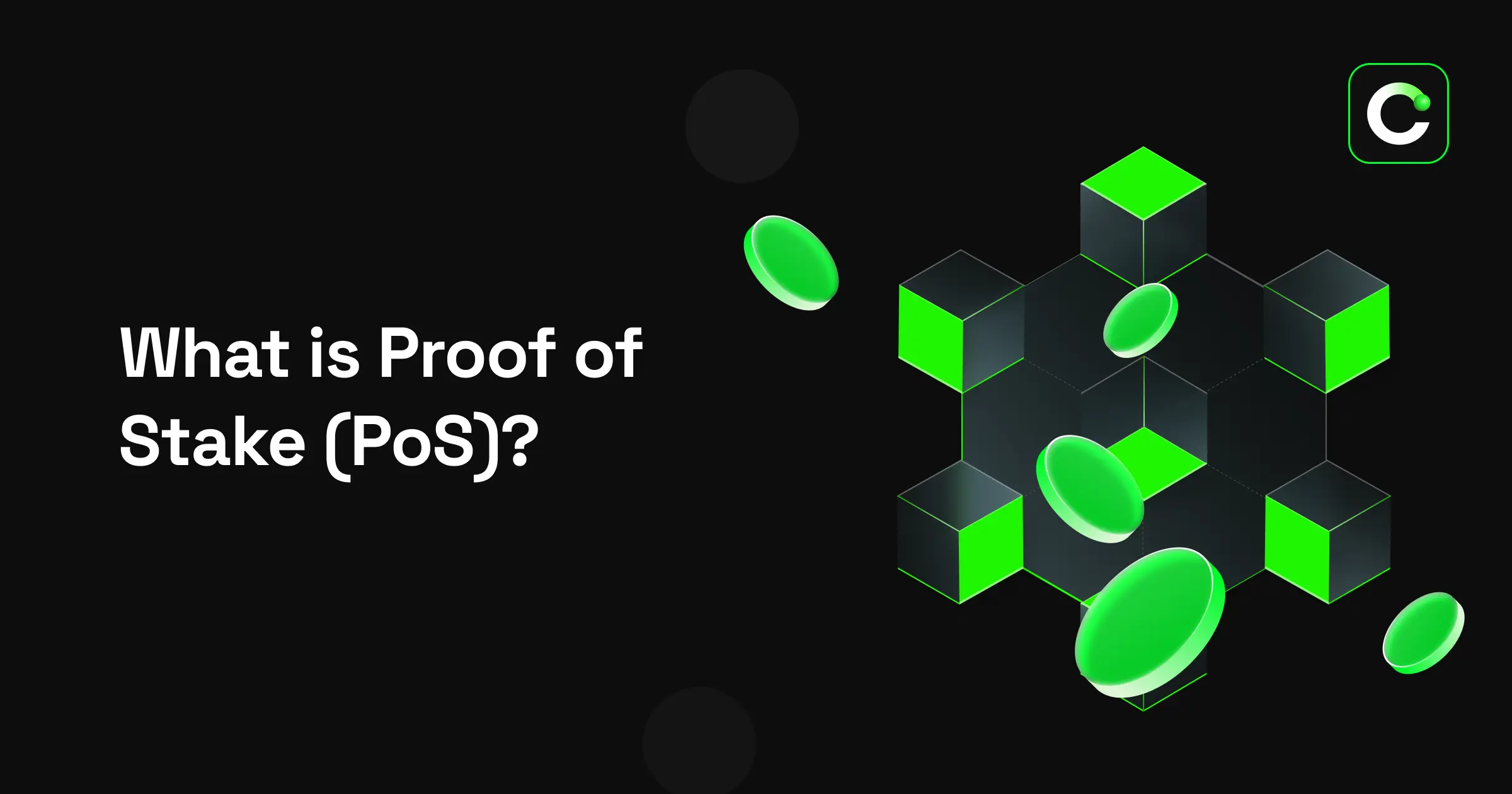What is Proof of Stake (PoS)? 

Cryptocurrency Exchange

Proof of Stake (PoS) is a consensus mechanism that manages transaction validation and new block creation processes in blockchain networks. The answer to the question "What is Proof of Stake?" is that PoS is a system where users can become validators on the network based on the amount of coins they hold. In this system, energy consumption is kept low, and the network’s security is ensured through staked assets.
Unlike the
Proof of Work (PoW) mechanism used by
Bitcoin, PoS does not require energy-intensive mining activities. Instead, users gain the chance to become validators by locking a certain amount of coins on the network. This mechanism makes the network more scalable and environmentally friendly.
PoS is preferred by many modern blockchain networks, especially Ethereum. The importance of PoS in the crypto world stems from the advantages it creates in terms of sustainability and transaction efficiency. It is important for crypto users to have knowledge about the staking process and security mechanisms to better understand this system.
Proof of Stake Fundamentals
At the core of Proof of Stake lies the principle "
coin amount = trust." The more cryptocurrency assets a user owns, the higher their chances of validating blocks. This system aims to economically deter malicious behavior on the network. Validators risk losing their staked coins if they approve fraudulent transactions.
Random selection, coin age, and holding duration can be factors involved in the validator selection process. In PoS systems, block producers are called “validators,” who verify transactions on the network, create blocks, and earn rewards. This fundamental structure optimizes transaction approval times while preserving network decentralization.
The Proof of Stake system enables blockchain infrastructures to operate more sustainably by balancing security, efficiency, and scalability. This understanding is critical for the future of cryptocurrencies.
Blockchain and Cryptocurrencies
Blockchain is a data structure where digital information is stored in a decentralized, transparent, and immutable way. Cryptocurrencies are digital assets operating on this infrastructure. Consensus mechanisms like Proof of Stake ensure the sustainability and security of these systems.
Cryptocurrencies are not only digital payment tools but also represent a transformation in the financial system. In this transformation, the role of PoS is important both for reducing environmental impact and encouraging broader user participation.
Blockchain technology forms the basis of systems that operate independently from central authorities. PoS contributes to the fast, low-cost, and secure functioning of these systems. Therefore, the relationship between cryptocurrencies and PoS includes not only technical but also philosophical and economic dimensions.
How Does Proof of Stake Work?

Proof of Stake works by validating transactions and producing new blocks in a blockchain network based on the amount of coins held by users. Instead of mining, this mechanism uses a process called “
staking.” Users gain the right to become validators by locking a certain amount of cryptocurrency on the network.
Validators are randomly selected to produce blocks. Factors such as the amount staked, the coin’s holding duration, or randomness may influence the selection process. Once blocks are validated, validators receive rewards. However, if malicious behavior is detected, staked assets may be partially or fully lost through a punishment method called slashing.
This system ensures security while eliminating the energy waste of mining. Thus, PoS offers a more environmentally friendly and efficient blockchain experience.
How to Do Proof of Stake?
To participate in the PoS system, one must first own a cryptocurrency supported by PoS. Then, these assets are locked in a wallet or staking platform on the relevant blockchain network.
The staking process usually involves the following steps:
-
Selecting a suitable coin: Acquire a PoS-compatible cryptocurrency such as Ethereum, Cardano, or Solana.
-
Setting up a wallet: Create a crypto wallet that supports the coin.
-
Staking: Coins are locked for a certain period, and users either become validators or delegate to existing validators.
Users can either run their own nodes to become validators or support existing validators to earn passive income. Coins locked during staking are generally inaccessible for a period determined by the network rules.
Advantages and Disadvantages of PoS
Proof of Stake (PoS) offers many advantages in terms of energy efficiency and network participation but also comes with some limitations. The table below shows the main pros and cons of the PoS system:
| Advantages | Disadvantages |
| Low energy consumption: No mining hardware needed, environmentally friendly. | Centralization risk: Large holders may have more control. |
| High scalability: Transactions are fast and cost-effective. | Complex for beginners: Delegation and staking can be confusing. |
| Passive income opportunity: Users earn rewards by staking coins. | Slashing risk: Validators not following rules may lose stakes. |
| Easy participation: Non-technical users can stake. | Long lock-up periods: Staked assets may be inaccessible for extended periods. |
PoS vs PoW
Proof of Stake (PoS) and
Proof of Work (PoW) are two fundamental consensus mechanisms used in blockchain networks. The difference lies in how transactions are validated and new blocks are created.
| Feature | Proof of Stake (PoS) | Proof of Work (PoW) |
| Energy Consumption | Low, environmentally friendly | High, mining devices consume energy |
| Transaction Speed | Faster, with low transaction fees | Relatively slower, possible network delays |
| Participation Requirement | Staking coins is sufficient | Requires specialized mining hardware |
| Security Model | Security ensured via economic risk (slashing) | Security via physical work and energy |
| Centralization Risk | Large investors may influence the network | Large mining pools risk centralization |
While early cryptocurrencies like Bitcoin use PoW, newer projects such as Ethereum have transitioned to PoS for better energy efficiency and scalability. Each system has unique strengths; the choice depends on network needs and philosophy.
Proof of Stake Coins
Many cryptocurrencies using the PoS mechanism attract users with their environmentally friendly nature and staking features. Below are some of the most well-known PoS coins and their systems:
Ethereum (ETH)
Ethereum initially operated with PoW but transitioned to PoS in 2022 with a major update known as "The Merge." This transition drastically reduced Ethereum’s energy consumption and activated the staking system.
To become a validator on the Ethereum network, a minimum of 32 ETH must be staked. However, users without this amount can participate through staking pools or centralized exchange platforms. Validators earn ETH rewards by confirming transactions and creating blocks. Ethereum’s PoS structure ensures network security through economic risk and punishes malicious validators.
Cardano (ADA)
Cardano is one of the first major blockchain projects developed entirely on a PoS algorithm. It uses an academically designed consensus algorithm called “Ouroboros,” aiming for a sustainable and scalable structure. This allows the network to operate securely and energy efficiently.
Users can become validators (stake pool operators) or delegate their ADA coins to existing validators to earn staking rewards. Coin staking in Cardano happens without lock-up periods, allowing users to access their coins anytime. This flexibility contributes to Cardano’s popularity.
Solana (SOL)
Solana stands out with its high transaction speed and low fees. It uses a hybrid PoS and Proof of History (PoH) consensus mechanism. It provides a powerful infrastructure for developers and a fast, efficient staking experience for users.
Running a validator node on Solana requires technical expertise and strong hardware, but delegators can easily participate in staking. Users delegate their coins to validators from their wallets to earn passive income. Solana’s fast transaction capacity leads to regular and short-term staking rewards.
Polkadot (DOT)
Polkadot is an innovative project enabling communication between multiple blockchains. Its security and transaction validation rely on a special PoS model called Nominated Proof of Stake (NPoS).
Users can be validators or nominators who delegate their coins to trustworthy validators. The selection process is democratic, and validators’ performance is regularly assessed. DOT stakers contribute to network security and earn rewards. Malicious validators are penalized via slashing.
Avalanche (AVAX)
Avalanche is a PoS-based blockchain platform known for high transaction speed and flexible network structure. It is ideal for DeFi, NFTs, and enterprise solutions. Its unique consensus algorithm enables transactions to be confirmed within seconds.
Generally, staking AVAX requires a minimum of 25 AVAX. Users lock their coins for periods ranging from two weeks to one year to become validators or delegators. During this time, coins remain inaccessible. Avalanche offers staking stability, transparency, and high earning potential.
Conclusion
Proof of Stake has secured an important place in the crypto ecosystem not only due to its energy efficiency but also because it enables users to directly contribute to network security. Today, many blockchain projects prioritize sustainability and participatory economy by adopting the PoS model. The transition of Ethereum and the growth of projects like Cardano and Solana demonstrate how this approach could become a standard in the long term. Correctly analyzing the opportunities and risks offered by PoS is crucial to better understanding this next-generation consensus model.
Recommended
- Cryptocurrency ExchangeWhat is a Stablecoin? 2025 Stablecoin List The cryptocurrency market is known for its high volatility, posing significant risks for investors. Stablecoins provide a secure alternative by maintaining a stable value. Typically pegged to fiat currencies, precious metals, or other assets, stablecoins serve as a safe haven for investors and traders. But what is a stablecoin, how does it work, and what types exist? Let’s dive into the details. What is a Stablecoin? A stablecoin is a type of cryptocurrency designed to maintain a stable value,
2024-11-24
- Cryptocurrency ExchangeWhat are Bear and Bull Markets? In financial markets, the terms bear market and bull market are often used to describe overall trends. A bear market represents periods of declining prices, while a bull market refers to rising trends. These terms are particularly important in the cryptocurrency market. But what exactly is a bear market, what is a bull market, and how long do these periods last? Here’s a detailed guide. What is a Bear Market? A bear market is a period when asset prices experience a prolonged decline, typically
2024-11-24
- Cryptocurrency ExchangeWhat is Blockchain Technology? Blockchain is an innovative technology used to securely and decentralizedly record digital transactions. Known as the backbone of cryptocurrencies like Bitcoin, blockchain technology has expanded into various industries with diverse applications. In this guide, we’ll explore what blockchain is, how it works, and its potential uses across different sectors. What is Blockchain? Blockchain is a decentralized database where information is stored across multiple computers. Each block records data an
2024-11-28


